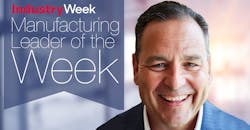A Successful Spin-off: Chemours CEO Mark Vergnano Reveals How It's Done
In July of 2015, Mark Vergnano was handed a difficult task. DuPont spun off its performance chemicals division, renamed Chemours, and asked Vergnano to come up with a plan to turn this spin-off into a viable business.
Vergnano was no stranger to the business. He joined DuPont in 1980 as a process engineer and held a variety of positions until he became group vice president of DuPont Safety and Protection in 2006. In 2009 he was named an executive vice president.
Vergnano combined his experience in the field with a firm transitional plan and brought the company from a shaky beginning to a solid success. It holds strong market positions in titanium technologies, fluoroproducts and chemical solutions. The stock recently climbed to an all-time high and has increased eight times in the past year. Second quarter sales in 2017 were $1.6 billion which is an increase of 15% over last’s second quarter.
IndustryWeek talked with Vergano to learn the secret to his success.
IW: What new processes did you have to put into place to create a successful company?
MW: The biggest change was to put into place values which became the basis of a fundamental cultural change. The first two values,Safety Obsession, and Unshakeable Integrity came from DuPont. The three new driving forces are; Customer Centered, Refreshing Simplicity, and Collective Entrepreneurship.
These values needed to be put into place as the new company had a lot of debt; some liability issues and we were at the bottom of the titanium market.
We needed a clear plan that was focused on controlling what we could control. We couldn’t wait for the market or the economy to get better.
IW: What were some specific actions that you undertook to achieve your goals?
MW: We had a five-point transition plan. The first was to look at our costs and make sure we were allocating costs correctly. We decided to take out $350 million by the end of 2017. So far we have reduced $300 million and we have identified another $150 of cost reductions. One way we achieved these cuts is by taking out layers of our organization and focusing on the most important areas.
Secondly, we had to get our portfolio right. We are a leader in fluoroproducts, mining solutions, and titanium technologies. We needed to invest in those areas. Our third plan was to invest in our future. To that end, we sold three businesses, which were solid businesses, but not our core business and the cash we received from those sales were invested into our core businesses. Fourth we further clarified which areas of the company needed additional investments. And fifth we worked on enhancing the organization through building strong cultural norms.
The results of this plan paid off. We are more transparent, we have hit clear milestones and we are faster.
IW: What type of workforce changes did you make?
MW: We simplified the organization. We did reduce the size of our organization. We have fewer layers and that enables people to understand their potential giving them the power to make decisions. It created a sense of ownership and a sense of accomplishment.
Everyone understood that they are responsible for approving things and there was a clear process which drove decision-making on a weekly basis. Everyone has decision rights. If they need help on Thursday morning employees have access to the leadership team to help make decisions.
This new process gives us both the speed we require and the sense of entrepreneurship that we desire.
IW: What best practices would you pass along to others who might be undergoing difficult transitions?
MW: Management must be very clear and consistent and have contact communication. We brought forward a lot of details. We were not shy about talking how we would change our portfolio. We were very clear about the areas that we were going to invest in.
While it was hard to sell some solid businesses we did and our people ended up in good places around the globe.
We talked openly about cost reduction and made it clear what we were doing every step of the way. We held back on salary increases for a year. Every person signed onto this and understood what was needed. When we were able we reinstated the salary increases.
IW: How would you describe your leadership style?
MW: There are three leadership traits that define my style; open, honest and transparent. These are my driving forces and I knew I needed to make this visible as the company transformed.
If you would ask people about my style they will tell you I try to be an authentic leader—nothing is hidden.
My style is to ask for input but I want participation. I like to make decisions quickly as trying to gather all of the intelligence within an organization is very time-consuming. It’s not about making the perfect decision all of the time. That gets people stuck in a morass. I’m comfortable with making a decision with 70% of the data available. I know that if we make a wrong decision we can fix it.
